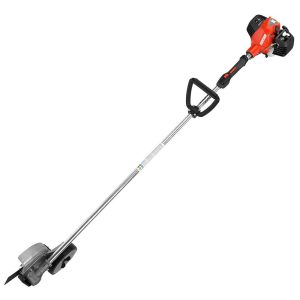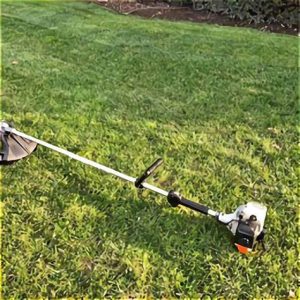9 Causes of an Edger’s Power Loss
The performance of your edger suffers when the engine is underpowered.
If the carburetor is dirty, the air filter is clogged, the fuel filter is plugged, the spark plug is dirty, the fuel line is clogged, the fuel tank vent is clogged, the spark arrestor is clogged, or the gasoline is faulty, the edger will bog down and lose power.
Please observe all of the safety measures outlined in your manual. Taking precautions like disconnecting the spark plug wire and letting the engine cool down before making repairs are essential.

Before diagnosing, repairing, or operating, be sure you’ve read and understood all of the safety recommendations in the equipment’s operator’s manual. If you are unsure about how to proceed or if you lack the necessary expertise or experience, you should seek the assistance of a professional.
Table of Contents
Edger Power Losses (9 Possible Causes)
A Gasoline Edger With Old Gas
Gasoline’s breakdown over time can affect an edger’s performance. Using stale gas can clog the fuel system and ruin the engine and carburetor.
Most gasoline contains ethanol, which is a moisture magnet. The residue that this ethanol and water combination leaves behind is varnish-like and sticky.
Fresh gasoline with an octane rating of 89 or higher and an ethanol level of no more than 10% is optimal for a tiny engine because ethanol is destructive to gasoline.
Premium 2-cycle engine oil and gasoline are a necessary combination for 2-cycle engines. To operate, 4-cycle engines need unleaded gas. However, STIHL’s 4-MIX engines, which operate on a combination of gas and oil, are an exception to this rule.
Suggestions for Buying and Storing Edger Fuel:
- Never put into your vehicle fuel labeled “E15,” “E30,” or “E85,” which indicates a greater ethanol percentage. These can range from 15% ethanol to 30% ethanol to 85% ethanol.
- Use all fuel up within 30 days. If you don’t use your edger at regular intervals, it can be hard to predict how much fuel you will go through.
- Fuel stabilizers can be used in with gas and oil to extend their shelf life.
Remove any stale gas from your edger’s tank. Fuel stabilizers like Sea Foam Motor Treatment and STA-BIL can be added to new gas.
The fuel will be more stable and the fuel system will be cleaner thanks to this product.
To circulate the new gasoline and fuel stabilizer through the fuel system, start the edger and let it run.
Air Filter Blocked in an Edger
An air filter removes debris from the air entering the engine. If you don’t clean or change your filter regularly, it might get clogged up and limit how much air can move through.
Edgers lose speed and power if they don’t get enough air.
The air filter should be cleaned several times a year and replaced annually. If you use your edger in extremely dusty conditions or more frequently than the typical homeowner, you may need to clean and replace it more frequently.
If your edger is struggling to run, you might be inclined to clear out the clogged air filter. Never do this, even if you need to multitask for a minute or two.
Doing so risks introducing dirt and debris into the engine, which can accelerate engine wear and damage.
The solution is to take out the air filter and its cover. Remove any lingering grime from the housing and the lid. Have the filter checked. A new air filter should be installed if the old one is too broken or unclean.
If the filter is still functional but just dusty, you can clean it with a brush and put it back in place.
Cleanse an edger FELT/FABRIC air filter:
- Take the air filter out of its housing.
- The felt air filter can be cleaned with water and a light detergent.
- Make sure the water coming out of the filter is clear, and then set it aside to dry in the air.
- Let it dry thoroughly in the air.
- Put the filter back in.
- The air filter cover must be reattached.
For information on how to clean different types of air filters, please refer to the relevant operator’s manual.
Unclean Edger Spark Plug
If your spark plugs are unclean, you may experience power loss. Take out the spark plug and inspect it.
A new spark plug should be installed if the old one is broken or has a particularly dark color.
A little wire brush can be used to clean a plug if the dirtiness is minimal. The plug is an essential part of a well functioning edger, thus I always make sure to change it.
The electrode gap should then be examined. This has to be gapped according to the manufacturer’s guidelines. Also, make sure the spark plug wire is attached tightly to the spark plug. A loss of power might be caused by a spark plug wire that is loose or has an improper gap.
An Edger’s Clogged Fuel Filter
The fuel filter is within the gas tank in case you’ve lost it. You should replace the fuel filter once a year, or more frequently if you use your edger more frequently than the typical homeowner or if you notice it is worn or damaged.
The fuel that passes through the fuel filter is discolored. Its purpose is to block dirt and other debris from entering the fuel supply.
If the fuel filter is blocked, the engine won’t get enough gasoline and will lose power.
If fuel is not getting through to the fuel line, check the fuel filter and replace it if necessary.
Ensure that the fuel is clean and pure by inspecting the tank for any signs of dirt or debris. Put in new, clean fuel if the old stuff is making the engine sputter.
An Edger’s Clogged Fuel Line
Gummy deposits left behind by old petrol might clog the fuel line. These can obstruct the engine’s fuel supply, reducing its efficiency and thus its power.
Check for obstructions in the fuel line as this could be the cause of the problem. If your fuel line is clogged, bent, or cracked, you need to get a new one.
An Edger’s Unclean Carburetor
To control the ratio of fuel to air for combustion, a carburetor is used. The tiny parts of your carburetor might get gummed up and stuck if you use old fuel, rendering it ineffective.
Clean your carburetor yourself if you’re at all mechanically inclined. Take apart the carburetor and use carburetor cleaner to get it sparkling clean.
You may need to rebuild the carburetor (if a rebuild kit is available) or get a new one if cleaning it does not restore its functionality.
Edger with Blocked Fuel Tank Vent
If the gasoline tank vent gets blocked, no fresh air can enter to keep the pressure in the tank constant.
When a fuel tank vent is blocked, a vacuum forms, preventing fuel from escaping.
If the fuel tank vent is blocked and the fuel lines are not clogged, the problem is likely with the fuel tank itself.
A pressure gauge test will reveal any suction issues. Try this if you don’t have a gauge:
- Get the edger going by turning on the engine.
- Set the edger down on a flat surface.
- To let air into the tank, loosen the fuel lid. Don’t let the gas leak out of the tank.
- If loosening the cap restores power to your edger’s motor, the problem was likely caused by the vent.
- If you encounter a loss of power when using the edger, you can be sure the vent is the source of the issue.
The gasoline tank cap or a line leading from the fuel tank are also possible locations for the vent. It’s time to get a new vent if the old one is giving you trouble.
Edging Tool with Blocked Spark Arrestor
A spark arrestor is a small metal screen used in the exhaust system to stop sparks and embers from escaping the muffler.
If this little screen is clogged, the edger may lose power and not spin at maximum speed.
The spark plug wire needs to be disconnected. Take off the hood and the exhaust cover. Take out the spark arrestor screen very cautiously. Use a metal brush to scrub it clean.
A new spark arrestor screen should be installed if the old one is too dirty, broken, or has a hole in it to be effectively cleaned.
Edger with Clogged Exhaust Port Due to Carbon Buildup
Your edger’s performance issues may be due to carbon deposits blocking the exhaust port behind the muffler.
If you’re still having electrical problems after doing the aforementioned troubleshooting steps, it may be time to clean this region.
The exhaust port and muffler should be cleaned by a qualified mechanic to prevent any harm to the edger.
Disconnect the spark plug wire and wait for the engine and muffler to cool before attempting any cleaning.
Take off the hood, the exhaust system, and the heat shield. Make that the port aperture is covered by the piston. The accumulation of carbon inside the cylinder will be prevented.
Carbon buildup around the exhaust port can be removed with a plastic scraper. Please, NO metal implements! Take care not to damage the piston or cylinder while you work.
Put back together the components in the same sequence as their removal.
When You Should Call an Expert to Fix Your Edger
If the preceding troubleshooting steps fail to restore power or if you lack the necessary mechanical know-how, it may be time to call in the experts at a small engine repair shop.
Someone you know and trust may have recommended a reliable small engine repair company in your area. You can also locate a local dealer who specializes in servicing your specific model of edger.
Check out these resources for local dealers:
- STIHL dealers
- ECHO dealers
- Husqvarna dealers
When I have a serious problem, I take my car to the dealership to get help from the factory’s skilled technicians. They’ve got all the testing gear they need.
Furthermore, they sell original equipment manufacturer (OEM) components and can handle warranty issues.
Think about the cost of the mechanic’s time to identify the issue before scheduling an appointment. In most cases, you should expect to pay a flat sum for the initial diagnosis, and then additional costs for labor and parts.
If you are using an inexpensive but aging edger, it may not be wise to pay for a diagnosis, new parts, and repairs.
Whether or not it’s worth fixing your current edger depends on factors including how old it is, how reliable it is, and how much it would cost. Buying a new edger could be the best option.







